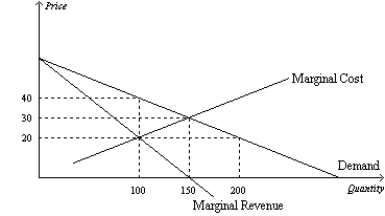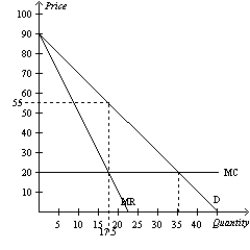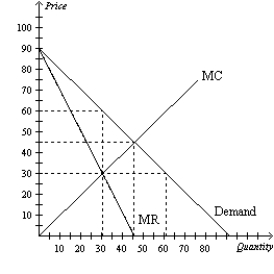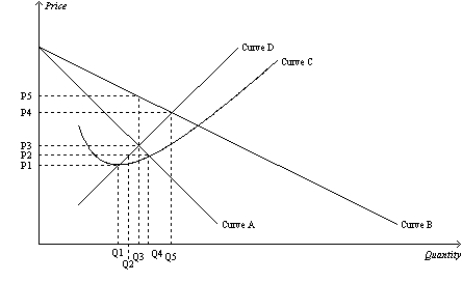A) (i) and (ii) only
B) (ii) and (iii) only
C) (i) and (iii) only
D) (i) , (ii) , and (iii)
F) A) and B)
Correct Answer

verified
Correct Answer
verified
Multiple Choice
The simplest way for a monopoly to arise is for a single firm to
A) decrease its price below its competitors' prices.
B) decrease production to increase demand for its product.
C) make pricing decisions jointly with other firms.
D) own a key resource.
F) C) and D)
Correct Answer

verified
Correct Answer
verified
Multiple Choice
The social cost of a monopoly is equal to its
A) economic profit.
B) fixed cost.
C) dead weight loss.
D) variable cost.
F) B) and C)
Correct Answer

verified
Correct Answer
verified
True/False
By selling hardcover books to die-hard fans and paperback books to less enthusiastic readers, the publisher is able to price discriminate and raise its profits.
B) False
Correct Answer

verified
Correct Answer
verified
Multiple Choice
The profit-maximization problem for a monopolist differs from that of a competitive firm in which of the following ways?
A) A competitive firm maximizes profit at the point where marginal revenue equals marginal cost; a monopolist maximizes profit at the point where marginal revenue exceeds marginal cost.
B) A competitive firm maximizes profit at the point where average revenue equals marginal cost; a monopolist maximizes profit at the point where average revenue exceeds marginal cost.
C) For a competitive firm, marginal revenue at the profit-maximizing level of output is equal to marginal revenue at all other levels of output; for a monopolist, marginal revenue at the profit-maximizing level of output is smaller than it is for larger levels of output.
D) For a profit-maximizing competitive firm, thinking at the margin is much more important than it is for a profit- maximizing monopolist.
F) All of the above
Correct Answer

verified
Correct Answer
verified
Multiple Choice
Price discrimination requires the firm to
A) separate customers according to their willingnesses to pay.
B) differentiate between different units of its product.
C) engage in arbitrage.
D) use coupons.
F) None of the above
Correct Answer

verified
Correct Answer
verified
Multiple Choice
Figure 15-9  -Refer to Figure 15-9. The deadweight loss caused by a profit-maximizing monopoly amounts to
-Refer to Figure 15-9. The deadweight loss caused by a profit-maximizing monopoly amounts to
A) $250.
B) $500.
C) $750.
D) $1,000.
F) A) and C)
Correct Answer

verified
Correct Answer
verified
Short Answer
Figure 15-22  -Refer to Figure 15-22. If the monopolist uses perfect price discrimination, how much output does the firm produce?
-Refer to Figure 15-22. If the monopolist uses perfect price discrimination, how much output does the firm produce?
Correct Answer

verified
Correct Answer
verified
Multiple Choice
Table 15-17
A monopolist faces the following demand curve:  -Refer to Table 15-17. If the marginal cost of production is constant at $18 per unit, this profit-maximizing monopolist will choose to produce
-Refer to Table 15-17. If the marginal cost of production is constant at $18 per unit, this profit-maximizing monopolist will choose to produce
A) 20 units.
B) 30 units.
C) 40 units.
D) 50 units.
F) A) and C)
Correct Answer

verified
Correct Answer
verified
Multiple Choice
Generic drugs enter the pharmaceutical drug market once
A) the ingredients to the name brand drug have been discovered.
B) 10 years have passed.
C) they are patented.
D) the patent on the name brand drug expires.
F) B) and D)
Correct Answer

verified
Correct Answer
verified
Multiple Choice
Because a monopolist does not face competition from other firms, the outcome in a market with a monopoly
A) does not illustrate profit maximization.
B) is often not in the best interest of society.
C) is characterized by unlimited profits.
D) would be improved if the government produced the product rather than a private firm.
F) B) and C)
Correct Answer

verified
Correct Answer
verified
Multiple Choice
In reality, perfect price discrimination is
A) used by about 75 percent of all monopolies.
B) used by about 50 percent of all monopolies.
C) seldom used by monopolies because it leads to lower profits.
D) rarely possible.
F) All of the above
Correct Answer

verified
Correct Answer
verified
Multiple Choice
Many economists criticize monopolists because they
A) charge a price that equals marginal cost rather than a price that equals average cost.
B) do not innovate.
C) produce a large quantity of waste.
D) produce less than the socially efficient level of output.
F) B) and C)
Correct Answer

verified
Correct Answer
verified
Multiple Choice
Figure 15-20  -Refer to Figure 15-20. The deadweight loss caused by a profit-maximizing monopoly amounts to
-Refer to Figure 15-20. The deadweight loss caused by a profit-maximizing monopoly amounts to
A) $225.
B) $450.
C) $900.
D) $1,350.
F) A) and C)
Correct Answer

verified
Correct Answer
verified
Multiple Choice
Antitrust laws allow the government to
A) collect revenues through the antitrust tax.
B) break up companies.
C) purchase privately-held companies through eminent domain.
D) All of the above are correct.
F) None of the above
Correct Answer

verified
Correct Answer
verified
Multiple Choice
The practice of selling the same goods to different customers at different prices, but with the same marginal cost, is known as
A) price segregation.
B) price discrimination.
C) arbitrage.
D) monopoly pricing.
F) C) and D)
Correct Answer

verified
Correct Answer
verified
Multiple Choice
Figure 15-4  -Refer to Figure 15-4. If the monopoly firm is currently producing Q4 units of output, then a decrease in output will necessarily cause profit to
-Refer to Figure 15-4. If the monopoly firm is currently producing Q4 units of output, then a decrease in output will necessarily cause profit to
A) remain unchanged.
B) decrease.
C) increase as long as the new level of output is at least Q2.
D) None of the above is correct. The monopolist currently maximizing profits at Q4.
F) B) and D)
Correct Answer

verified
Correct Answer
verified
Multiple Choice
Splitting up a monopoly is often justified on the grounds that
A) consumers prefer dealing with small firms.
B) small firms have lower costs.
C) competition is inherently efficient.
D) small firms produce higher quality products.
F) None of the above
Correct Answer

verified
Correct Answer
verified
Multiple Choice
Scenario 15-8 Mega Media Cable TV is able to purchase an exclusive right to sell a premium sports channel in its market area. Let's assume that Mega Media pays $100,000 a year for the exclusive marketing rights to the sports channel. Since Mega Media has already installed cable to all of the homes in its market area, the marginal cost of delivering the sports channel to subscribers is zero. The manager of Mega Media needs to know what price to charge for the sports channel service to maximize her profit. Before setting price, she hires an economist to estimate demand for the sports channel. The economist discovers that there are two types of subscribers who value premium sporting channels. First are the 3,000 die-hard sports fans who will pay as much as $150 a year for the new channel. Second, the premium sports channel will appeal to 20,000 occasional sports viewers who will pay as much as $25 a year for a subscription to it. -Refer to Scenario 15-8. How much profit will Mega Media Cable TV earn if it sets the price at $25?
A) $350,000
B) $450,000
C) $475,000
D) $575,000
F) B) and C)
Correct Answer

verified
Correct Answer
verified
Multiple Choice
The economic inefficiency of a monopolist can be measured by the
A) deadweight loss.
B) value of the unrealized trades that could be made if the monopolist produced the socially-efficient output.
C) area above marginal cost but beneath demand from the monopoly output to the socially-efficient output.
D) All of the above are correct.
F) None of the above
Correct Answer

verified
Correct Answer
verified
Showing 381 - 400 of 637
Related Exams